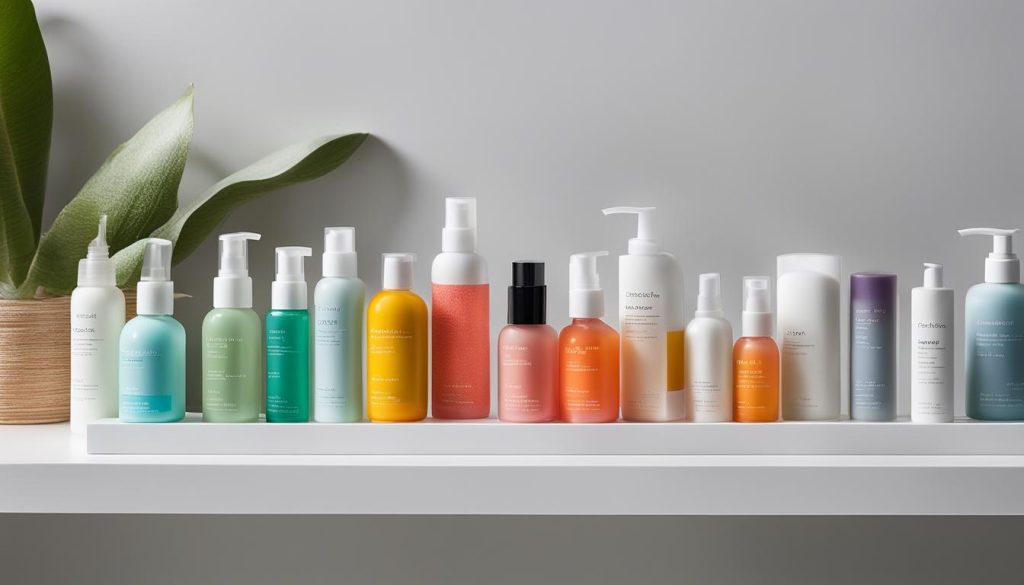As a seasoned journalist dedicated to the intricacies of skincare, I’ve constantly been in search of the definitive guide on how to properly wash my face. A dermatologist hailing from Scottsdale, Arizona, has enlightened me on the remarkable face washing tips that underscore the necessity of cleansing twice a day. This act isn’t just about clearing away the day’s makeup and pollutants; it’s a critical facet of priming our skin for rejuvenation and its natural overnight repair.
Diving into my experience with proper face washing techniques, I’ve learned it’s not merely about what you remove, but how you remove it. Implementing a facial cleansing method tailored to your skin’s needs can transform your complexion. Integrating gentle face washing techniques into your daily regime ensures even the most resilient of skin types remain free from the menace of clogged pores and dreaded breakouts.
How to Wash Your Face
- Daily cleansing is crucial for skin health, assisting natural repair and preventing acne.
- Utilize gentle makeup removers to prepare the skin for a deeper cleanse.
- Adopting a double cleansing method can thoroughly purify skin without overstripping it.
- Always choose a technique that is kind to your skin, avoiding harsh physical scrubbing.
- Include mild, skin-type suitable products to fortify the skin’s natural barrier.
Understanding the Importance of Face Washing
The active pursuit of the best face wash routine goes far beyond aesthetics; it’s a fundamental aspect of fostering a healthy skincare routine. As I delve deeper into the skin’s needs, I observe that the facial cleansing steps I follow play a pivotal role in my skin’s ability to heal and rejuvenate itself. Dr. Jennifer Haley, a respected dermatologist, underscores this by asserting that evening cleansing is more than just a ritual: it’s a critical measure for stripping away day-long accumulation of pollutants.
Why emphasize this regimen every night? The coherence lies in the skin’s natural nocturnal behavior—where the focus shifts from protecting against external stresses to healing. Skipping out on an effective face washing method beforehand could impede this restorative cycle.
- Every evening, my skin begs to be rid of makeup and environmental toxins. Even on makeup-free days, invisible pollutants can wreak havoc on my skin’s surface.
- I realize that skin type is irrelevant in the matter of face cleansing; the universal language of skincare recognizes that everyone benefits from a nightly cleanse.
- Embracing these cleansing fundamentals is more than practicing good hygiene; it’s granting my skin the fresh slate necessary to optimally absorb the carefully curated products that follow.
While the simplicity of water and soap might seem appealing, the modern approach to a thorough cleanse involves more sophistication and understanding of the skin’s delicate balance. Therefore, an effective face washing method is not just desired, but imperative for maintaining the integrity of the largest organ that shields me—the skin.
Choosing Your Facial Cleanser Wisely
When it comes to daily skincare, understanding what should you wash your face with is not just about personal preference but about what benefits your skin the most. As someone who values their skin’s health, I am acutely aware of the importance of selecting the right facial cleansers. Dermatologists like Erum Ilyas and Joshua Zeichner stress the significance of aligning your choice of cleanser with your skin type to promote optimal skin health.

Consider Your Skin Type: Dry, Oily, or Combination?
Identifying your skin type is the first critical step in selecting a cleanser. For those with dry or sensitive skin, nonfoaming and hydrating cleansers ensure nourishment without stripping the skin of its natural oils. Conversely, if you have oily or acne-prone skin, foaming or salicylic acid–based cleansers can be incredibly effective in reducing excess sebum and preventing breakouts.
Ingredients That Make a Difference
With myriad options available, it’s essential to know what to wash face with in terms of ingredient composition. Look for ingredients like salicylic acid for combating acne, glycolic acid and lactic acid for their exfoliating capabilities, and hyaluronic acid for its unparalleled moisturizing properties. These ingredients can help promote a clearer, smoother, and more radiant complexion.
Recommended Cleansers for Every Skin Type
- For dry or sensitive skin, products like Cetaphil Gentle Skin Cleanser are a go-to recommendation by skin professionals for their gentle and hydrating formula.
- For those battling oily skin, CeraVe Renewing Salicylic Acid Cleanser is often proposed to help with exfoliation and maintaining clean, clear pores.
- Combination skin can benefit from a balanced cleanser that addresses oiliness in the T-zone without overdrying the cheeks.
As a committed advocate for proper skin care, I urge you to consider these aspects when choosing your facial cleansers. Remember, a wise choice goes a long way in maintaining the allure and health of your complexion.
How to Wash Your Face
Understanding how to wash your face properly is key to maintaining a glowing complexion. To demystify the process, I’ll guide you through the best way to wash your face, ensuring you can clean your face effectively without causing undue stress to your skin. The mantra is simple: be kind to your skin and it will reflect its gratitude through its condition and appearance.
The journey to a pristine face begins with makeup removal. Trust in a reliable ally like micellar water, which captures and lifts away dirt and cosmetics without the need for aggressive rubbing. The next crucial step is choosing the right cleanser—one that harmonizes with your skin’s pH balance, keeping unfriendly bacteria and yeast at bay.
When it comes time to apply your cleanser, forget the bristle brush or rough washcloths. Your fingertips are the best tools you have: they’re gentle yet effective. Massage the cleanser into your skin in a delicate, circular motion heading upwards, paying special attention to the neck and jawline. This not only removes grime but also boosts circulation, which is beneficial for skin health and vitality.
- Avoid vigorous scrubbing to maintain the natural skin barrier.
- Use an upward motion to massage the cleanser into your skin with your fingertips.
- Include the neck in your routine to ensure a thorough clean.
After rinsing, pat your skin dry with a soft antimicrobial towel. Why pat instead of rub? Because patting is less likely to cause irritation or exacerbate any sensitivities. Essentially, the aftermath of washing your face should leave you feeling refreshed and calm, not inflamed or overly dry.
Incorporating these steps into my daily regimen has not only improved my skin’s appearance but has also become a therapeutic ritual. It’s a chance to tend to my skin’s needs, forging a connection with its natural rhythm. With each wash, remember the golden rule: treat your face as you would a masterpiece, because that is indeed what it is.
The Role of Water Temperature in Face Washing
As I delve into the best face washing techniques, I am often reminded that it’s not just the products that affect my skin, but also the temperature of the water I use. Distinguished dermatologist Dendy Engelman has highlighted the importance of this often-overlooked detail. Cold water, for instance, doesn’t just rouse me in the morning but also offers unique benefits to my complexion.

Engelman’s insights compel me to incorporate step-by-step face washing instructions with ideal water temperatures. Based on my research and professional advice, I’ve compiled the following tips to guide you through a gentle face washing experience:
- Begin with lukewarm water to wet your face. This temperature helps avoid irritation and maintains the comfort of your skin.
- Gently apply your preferred facial cleanser in a circular motion. Understanding that hot water might feel soothing but can lead to dryness, I stick to lukewarm temperatures throughout this step.
- Rinse thoroughly with lukewarm water, ensuring not to disrupt the skin’s natural balance.
- Finish with a splash of cold water. The chill acts as a natural astringent, enhancing blood circulation and tightening my pores.
The takeaway from experts and my personal practice resonates with adherence to face washing instructions that prioritize skin health. Whether I’m preparing my skin for the day ahead or winding down for the night, using water at the correct temperature remains a pivotal part of my skincare ritual.
Maintaining Skin Health Post-Washing
After delving into the essential steps of a proper face cleansing regimen, we reach a crucial juncture that significantly impacts the skin’s vitality and resilience. Once you have mastered your face washing routine, the attention must seamlessly flow to the post-cleansing practices that preserve and enhance your skin’s natural balance.
Proper Pat-Drying Techniques for Sensitive Skin
As someone who cherishes the comfort of their skin, I can’t overemphasize the importance of pat-drying. The abrasive action of harshly drying your face can not only irritate sensitive skin but also contribute to premature wrinkling over time. Here’s my go-to strategy: I use a plush, gentle towel and meticulously pat the skin dry. This ensures that the moisture needed for a supple texture remains, while unwanted water is removed effectively.
The Importance of Moisturizing After Cleansing
Implementing a facial cleansing method that cleans without stripping is only half the battle; it’s the immediate follow-up with a quality moisturizer like the Water Cream by Tatcha that secures victory. This cream is a wonder, locking in hydration with a featherlight touch that doesn’t clog pores or leave a greasy residue. Especially when combined with serums or acne treatments, it acts as the perfect buffer, enhancing efficacy while warding off irritation.
Choosing the Right Moisturizer for Your Skin Type
In my pursuit of the best face wash routine, I’ve found that selecting the right moisturizer is as much science as it is personal preference. For my clients with dry skin, I recommend oil-based formulations that build upon the moisture introduced during cleansing. If you’re someone with oilier skin, a gel-based moisturizer that hydrates without adding shine could be your holy grail. In essence, the substance that follows your cleanser seals your skin’s fate, so choose with thoughtfulness and care.
Daily Cleaning or Over-Cleansing: Finding the Balance
As a dedicated advocate for the best ways to wash your face, I’m here to share key insights on achieving a facial cleansing routine that safeguards your skin’s natural harmony. While we seek the glowing results from proper cleansing techniques, it’s imperative to recognize that there’s a fine line between thorough cleansing and over-doing it. Striking the right balance not only promotes a healthy complexion but also prevents the adverse effects associated with excessive washing.
Signs You Might be Over-Washing Your Face
Are you experiencing dryness, a sensation of tightness, or perhaps flakiness in your skin? These can be cautionary signs indicating that your cleansing habits might be stripping away the essential oils that keep your skin balanced and moisturized. Redness and irritation are also common symptoms that warrant a reevaluation of how you wash your face correctly. It’s my personal commitment to help you recognize these signs and guide you through adjusting your skincare routine accordingly.
Adjusting Your Routine to Your Skin’s Needs
Guided by dermatologists’ expertise, I find that catering your facial cleansing routine to your unique skin condition is non-negotiable. If you’re grappling with the aftermath of over-cleansing, tepid water can be your ally, milder cleanser choices become paramount, and reducing the frequency of washes may be necessary. My experience underscores the virtue of listening to your skin and adapting your regimen to restore its natural luster.
When to Scale Back and How to Supplement Your Skincare Regimen
I vouch for evening cleansing as an ideal practice fitting naturally within the skin’s circadian rhythm, effectively removing the day’s accumulation of pollutants and makeup. But if signs of over-cleansing emerge, it’s time to consider scaling back. Complementing your regime with nourishing products can replenish and maintain moisture. My advice? Never underestimate the benefits of a well-formulated moisturizer following your carefully moderated cleansing routine.
Conclusion
In wrapping up, I’ve learned that mastering how to wash your face correctly is not just basic hygiene; it’s an integral component of a comprehensive skincare regime essential for maintaining the skin’s vitality and luster. As we’ve explored various facial cleansing methods and face washing instructions, it is clear that personalization and adherence to expert guidance are the keys to fostering a glowing complexion.
By selecting the right products and embracing a routine attuned to my skin’s unique needs, I’m empowering myself to fight against daily pollutants and stressors that affect my skin’s health. The importance of a tailored approach to skincare cannot be overstated, and I’m reminded that it’s not merely about cleansing, but nurturing my skin in a manner that compliments its natural properties.
Ultimately, ensuring that I am equipped with the knowledge of how to wash my face correctly grants me the ability to cultivate a radiant and youthful skin appearance that resonates with wellness and self-care. By meticulously following the expert-backed practices discussed, I am confident of achieving the best outcomes for my skin’s health and presenting my best face forward, each and every day.
FAQ
What Is the Proper Way to Wash My Face?
The proper way to wash your face involves five steps: First, begin with removing makeup with a gentle remover like micellar water. Second, use a cleanser suitable for your skin type without over-stripping it of natural oils. Third, while washing, avoid vigorous scrubbing and use your fingertips in a gentle upward motion. Fourth, rinse with lukewarm water to avoid irritation. Finally, pat your face dry with a soft towel rather than rubbing, to maintain the integrity of your skin barrier.
How Often Should I Wash My Face?
Dermatologists recommend washing your face twice a day, in the morning and at night. Nighttime cleansing is particularly important to remove makeup, dirt, and pollutants that have accumulated throughout the day. However, over-washing can lead to dryness and irritation, especially for those with dry or sensitive skin types.
What Should I Consider When Choosing a Facial Cleanser?
When choosing a facial cleanser, consider your skin type—whether it’s dry, oily, or combination. Look for cleansers with ingredients that align with your skin concerns, such as salicylic acid for acne-prone skin or glycerin and hyaluronic acid for dry skin. Popular dermatologist-recommended options include Cetaphil Gentle Skin Cleanser and CeraVe Renewing Salicylic Acid Cleanser.
Can Water Temperature Affect My Skin During Face Washing?
Yes, water temperature can greatly affect your skin’s health. Dermatologists suggest using lukewarm water to avoid irritation. Extreme temperatures, either hot or cold, can be harsh on your skin. Lukewarm water is ideal for preventing the risk of irritation and preserving skin comfort. Some dermatologists advocate using cold water to tighten the skin and reduce pore size, but it’s important to know how your individual skin reacts to temperature changes.
What Are Some Gentle Face Washing Techniques?
Gentle face washing techniques involve using light pressure with the fingertips, avoiding the use of rough cloths or scrubs that can damage the skin. Cleanse in a circular motion, focusing on the T-zone and areas that need more attention while being mindful of the delicate eye area. Rinse thoroughly but gently, and always follow up with a moisturizer suitable for your skin type to lock in hydration.
Why Is Moisturizing Important After Washing My Face?
Moisturizing immediately after washing helps to replenish the skin’s natural moisture barrier, which can be disrupted during cleansing. It also helps to prevent transepidermal water loss, keeping the skin hydrated and supple. Choosing a moisturizer that is right for your skin type ensures that your skin receives the correct balance of hydration without causing congestion or greasiness.
What Are the Signs I Might Be Over-Washing My Face?
Signs of over-washing include tightness, dryness, peeling, redness, and increased sensitivity or irritation. If you notice any of these symptoms, consider reducing the frequency or intensity of your cleansing routine, and opt for more gentle, hydrating cleansing options. It might also be a cue to review the ingredients in your skincare products, as they can also contribute to these reactions.
How Can I Adjust My Face Washing Routine If My Skin Is Dry or Irritated?
If your skin feels dry or irritated, adjust your routine by choosing a gentle non-foaming cleanser and reduce the temperature of the water to lukewarm. Avoid using physical exfoliants, and apply a richer, more hydrating moisturizer after cleansing. Also consider incorporating products with soothing ingredients like aloe vera or chamomile, and ensure adequate hydration by drinking plenty of water.
What Facial Cleansing Steps Should I Follow for a Thorough Cleanse?
For a thorough and effective cleanse, start with removing makeup and sunscreen with a designated makeup remover or cleansing oil. Then use a gentle pH-balanced cleanser suitable for your skin type to cleanse the skin, preferably through double-cleansing if you wear heavy makeup or sunscreen. Patting your face dry with a soft towel and immediately following up with a moisturizer will help ensure that your face is not only clean but also well-maintained.
When Is the Best Time to Wash My Face?
The best time to wash your face is in the morning when you wake up and at night before bed. Morning cleansing helps to remove oils and sweat that have accumulated overnight, preparing your skin for your daytime skincare products. Nighttime cleansing is crucial as it removes makeup, dirt, and pollutants, allowing your skin to repair and regenerate while you sleep.






